The Copa América clash between Uruguay and Panama was a tactical feast that kept fans on the edge of their seats. As these two teams clashed on the field, their strategic approaches were evident, with each team showcasing distinct tactical game plans that highlighted their strengths and exposed their vulnerabilities.
This tactical analysis piece delves into the tactical aspects of the match, providing an analysis of both teams’ tactics on the pitch.
Looking ahead, we’ll also explore the strategies that Uruguay and Panama might employ in their upcoming fixtures as they seek to capitalise on their experience from this encounter and refine their approaches for future matches.
Both Teams’ Tactical Setups
Marcelo Bielsa successfully implemented his signature philosophy into the Uruguayan team, which was characterised by aggressive man-marking, counter-pressing with a high line, and a build-up in a 3-4-3 formation. For this match, Panama chose a 4-5-1 defensive setup, aiming to counter Uruguay’s two-line defensive lines. While Panama’s strategy seemed effective for about 35 minutes of dominance in the match, they ultimately failed to earn any points due to their inability to finish their chances effectively.
In the image below, we can observe both Panama’s defensive formation and Uruguay’s attacking strategy. Uruguay deployed extremely high full-backs to stretch Panama’s mid-block and create space for midfielders to advance into attacking positions alongside striker Darwin Núñez.
Conversely, Panama’s setup was stretched wider, leaving gaps that allowed Uruguay’s full-backs ample room to execute crosses into the box or facilitate easier passing sequences with midfielders. This set the stage for a classic tactical duel: Uruguay’s 3-4-3 offensive alignment versus Panama’s 5-4-1 defensive mid-block. Although Panama ultimately lost the match 3-1, their defensive setup managed to contain Uruguay effectively until the final minutes—around the 85th minute—when their players began to lose stamina and could no longer perform at full capacity, where Uruguay finished the match off with a second goal.
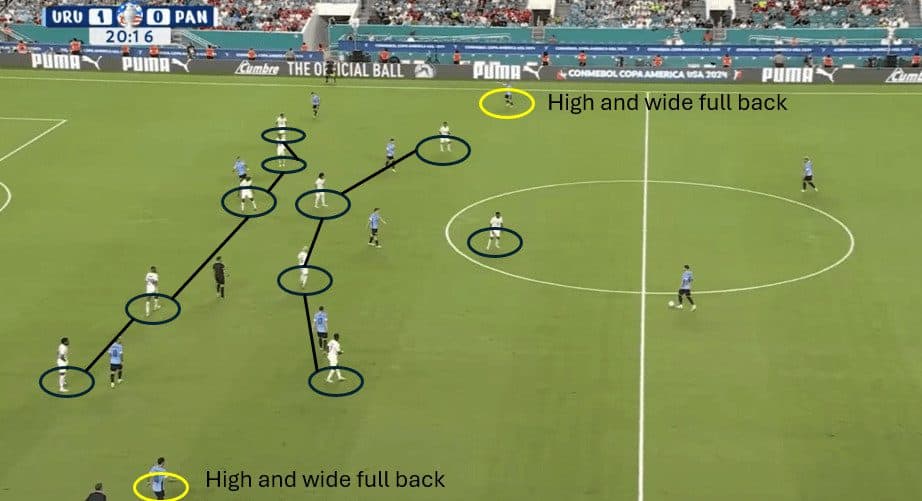
Below is another image displaying the same exact tactical setup from both teams in another segment of the first half of the match. This illustrates how consistently both teams applied their strategies throughout the game.
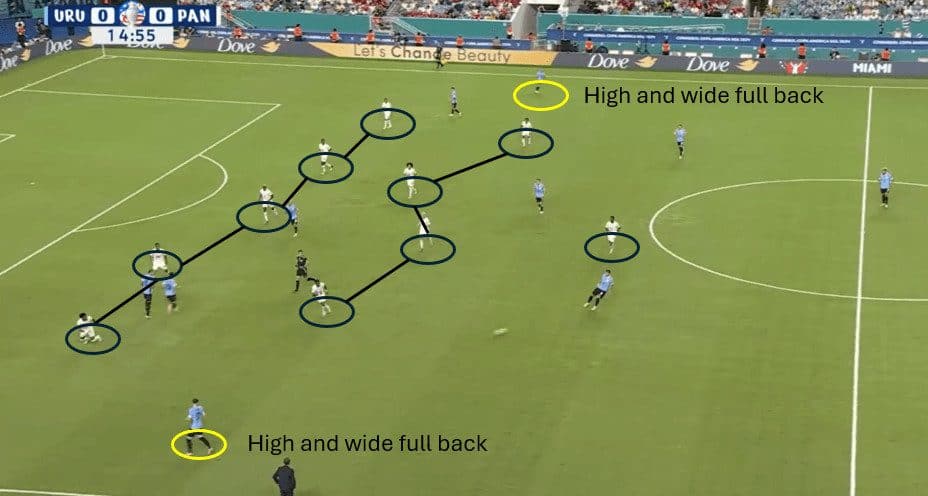
Uruguay Build-up
Uruguay’s build-up play significantly differs from that of Panama, a point I will elaborate on shortly. The strategy involves Federico Valverde and Manuel Ugarte dropping back into a double pivot to function as deep-lying playmakers. This tactic leverages the exceptional skills of these two midfielders, who are not only technically proficient but also highly intelligent in facilitating the build-up play. Their experience and prowess at top clubs like Real Madrid and PSG have greatly benefited Uruguay’s tactical approach.
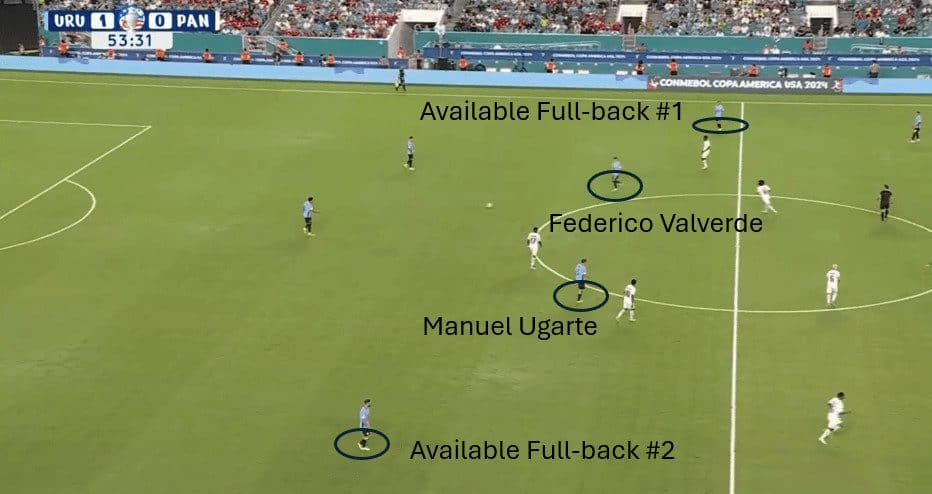
After receiving the ball, the deep-lying playmakers will look to advance play by moving the ball forward, supported by high wingbacks who push up to add numbers in attack.
If the forward progression is stalled, the deep-lying playmakers have the option to recycle the ball back to the centre-backs. These defenders then distribute the ball to the wide players, facilitating an alternative route to continue the attack.
This dynamic can be seen in the image below, which demonstrates Uruguay’s strategic flexibility in moving the ball. Either center back has the correct angle aligned with their full-back to play a progressive ball forward, as seen in this image, the RCB plays into passing option #2.
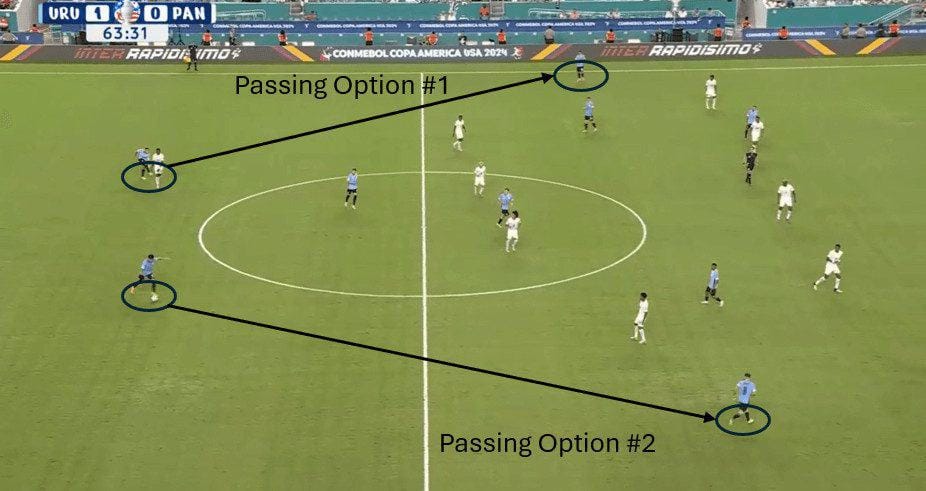
Panama Build-Up
Panama adopted a different strategy to counter Uruguay’s high press and man-marking tactics. Instead of attempting to exploit spaces through passing sequences, Panama regularly opted for long balls during their build-up. This approach was designed to bypass the first three-man line of defence that Uruguay had set up.
The first image shows the man-marking on Panama’s centre-backs and their holding midfielder, as well as the full-back in the bottom right.
In the second image, we see the long ball being played directly to the feet of their striker. This strategy effectively bypassed both the first and second defensive lines of Uruguay. If executed correctly, it allows their striker the opportunity to either play the ball back to the midfielders to advance forward or even turn and make a run towards the goal.
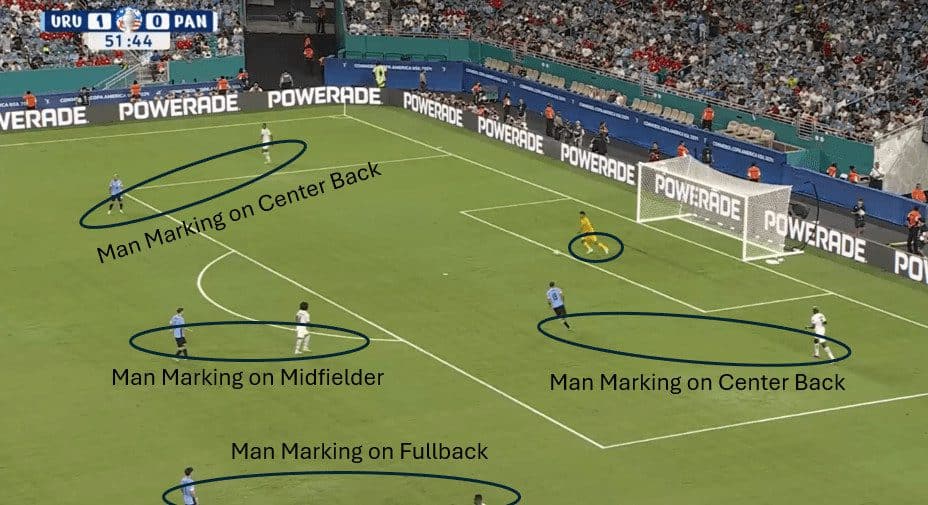
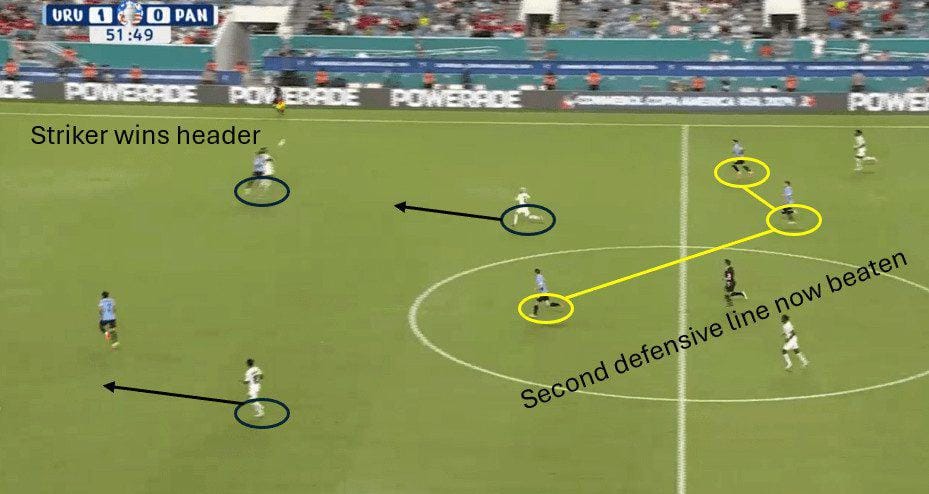
The images below show how Panama’s strategy of playing long passes could have been advantageous. Once again, the ball was launched from their goalkeeper deep towards their striker. A misjudgment by the Uruguayan defender allowed the Panamanian striker to gain possession in a position where he could run a few yards towards the goal before being cut off by a defender, forcing a shot out of the Panama striker. This tactic nearly allowed Panama to equalise, demonstrating the potential effectiveness of their long-ball approach under pressure.
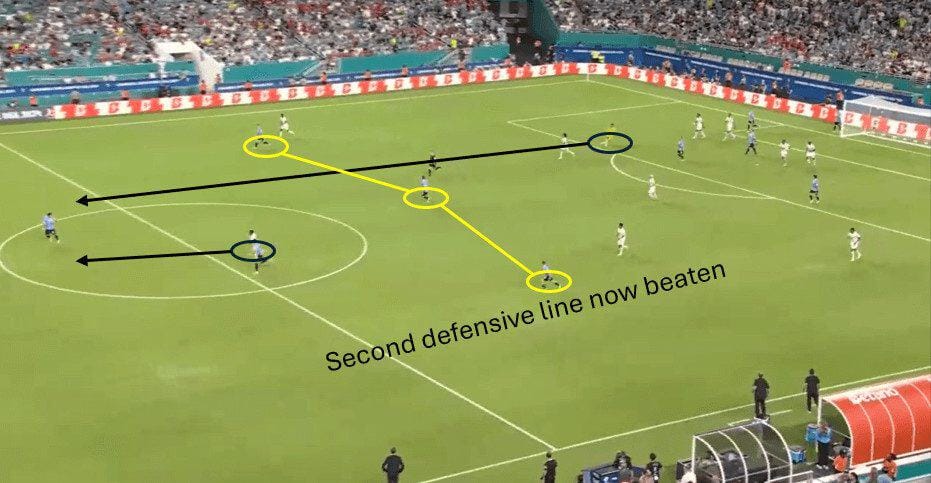
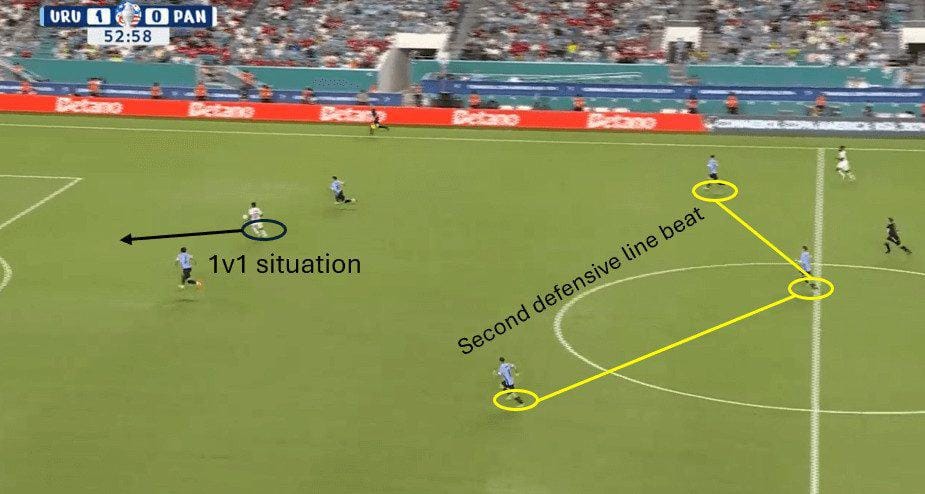
Individual Brilliance
Federico Valverde emerged as a standout player in the match, as expected. He was involved for 84 minutes, managed 60 touches, and achieved an impressive 85% pass completion rate with 41 successful passes out of 48 attempts. Additionally, Valverde completed 70% of his long balls, with 7 out of 10 attempts finding their mark, and won 100% of his ground and aerial duels. Below is Valverde’s pass map, which clearly illustrates his crucial role in advancing his team’s play. The majority of his passes were directed towards the right flank of the pitch, where Pellistri took the role of a ball carrier, similar to the styles of players like Grealish, Barcola, and Saka.
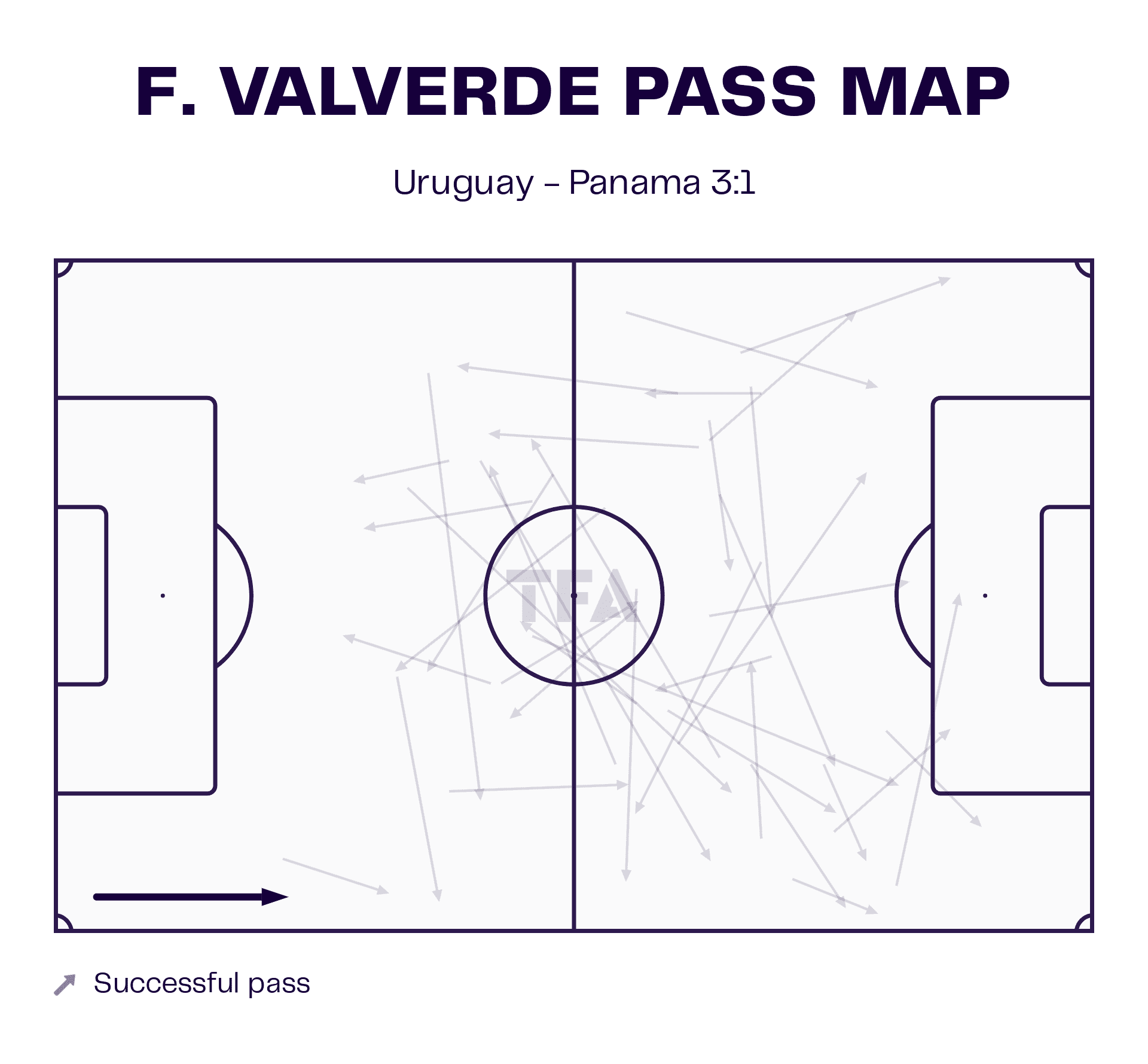
Below is the progressive pass map from Valverde, where we observe two significant chances created. This indicates that Valverde, alongside Ugarte, not only functioned as a deep-lying playmaker but also served as a critical creative outlet for Uruguay. This dual role underscores his importance in both orchestrating the midfield and catalyzing offensive opportunities.
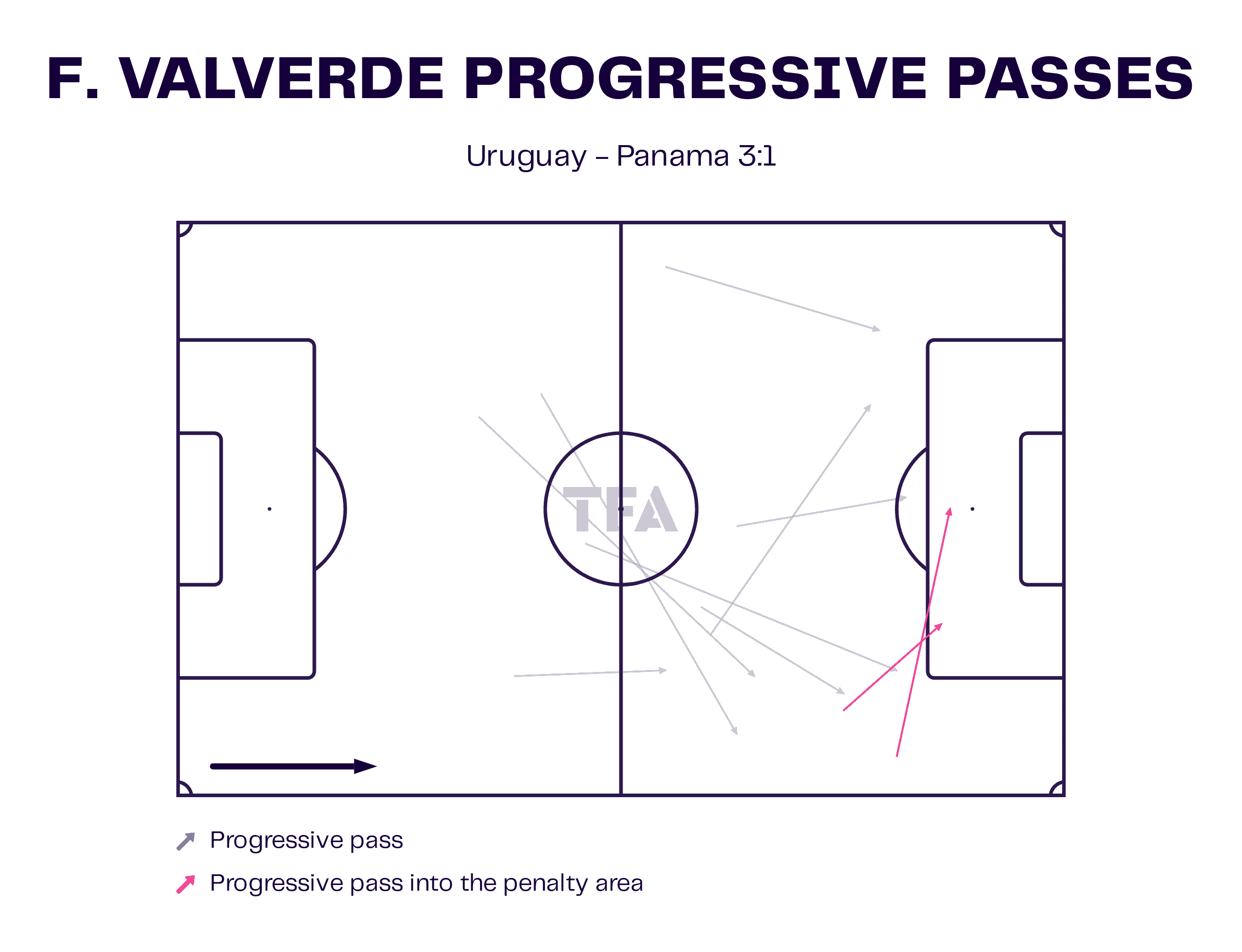
The heatmap of Valverde during the Uruguay vs. Panama match vividly illustrates his dynamic presence on the field, underscoring his pivotal role in Uruguay’s 3-1 victory. Valverde’s movements covered a substantial area across the midfield, showing clusters of activity that span from deep in his own half to well into the attacking third. Notably, there is a significant concentration of activity around the centre circle and extending towards both flanks, indicating his involvement in distributing the play and linking the defence with the attack.
His coverage isn’t confined to the central areas, the heatmap also shows frequent excursions down the right flank, supporting wide plays and contributing to overlaps. The less intense but still noticeable spots in the attacking third near the penalty box suggest moments where he pushed forward to join attacks or positioned himself for potential shots or final passes.
This extensive coverage across the pitch confirms Valverde’s role as a versatile and tireless midfielder. He is capable of influencing the game on both ends and providing his team with defensive solidity and creative spark. His presence was key in controlling the midfield battle and driving Uruguay’s attack forward in this match.
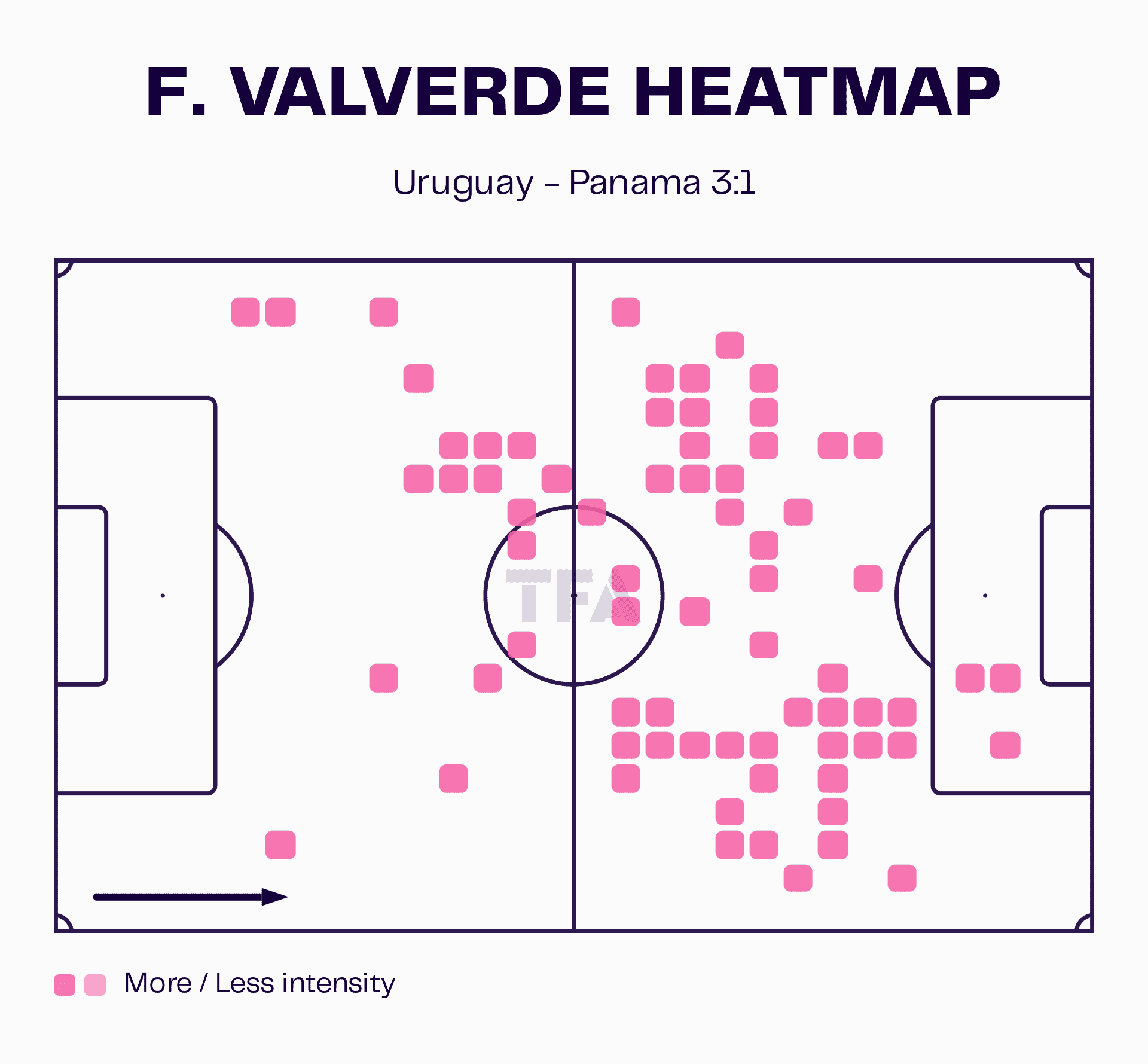
Strengths and Weaknesses of Both Teams
Strengths of Uruguay, Weaknesses of Panama
Uruguay’s strength lay in their tactical setup, featuring intense build-up play and aggressive man-marking. This strategy compelled Panama into uncomfortable positions, forcing them to opt for long passes instead of methodically building up from the back. Concurrently, this highlights Panama’s weakness: their discomfort and lack of confidence in building play against stronger teams. This is evident in their shift to a five-back formation, deviating from their usual four-back setup seen in previous international matches.
Strengths of Panama, Weaknesses of Uruguay
Panama demonstrated strong positional integrity, adhering firmly to their 5-4-1 mid-block/low-block and executing counterattacking football effectively. They remained composed under constant pressure from Uruguay, sticking to their tactical game plan without showing signs of frustration. During several periods, particularly in the second half, they successfully managed to build from the midfield and dominate possession as the pressure on Uruguay intensified. This approach highlighted a vulnerability in Uruguay’s strategy. Uruguay’s commitment to an aggressive tactical setup involving a defensive man block at the front line posed risks.
Although this tactic worked in their favour for most of the game, Panama began exploiting it in the latter stages. The excessive counterpressing and man-marking eventually fatigued the Uruguayan players, leading to a noticeable dip in their performance. This forced Bielsa to make two substitutions in the second half, in the 60th minute, pulling off some of his key players to maintain match fitness.
What to Expect in Their Next Matches
Uruguay will confidently take these three points and move on to their next match against Bolivia. We anticipate that Uruguay will field a lineup similar to their initial game and employ the same tactical plan. Given that Bolivia is considered a weaker team than Panama, Uruguay will likely use the same strategy that proved effective against Panama, relying on their attacking prowess (Nunez, Pellistri, Araujo, Valverde). Coach Bielsa, known for his adherence to his philosophy, is expected to maintain this tactical setup throughout the tournament.
For Panama, an intriguing match awaits them against the USMNT, a team positioned between being considered a strong and a weak national team. It’s challenging to predict how Panama will line up, if they view themselves as inferior compared to the USMNT, they might opt for a similar formation to the one used against Uruguay, employing a 5-4-1 midblock/lowblock. Alternatively, if they feel they can compete or are superior, they might revert to their usual 4-5-1 formation to exert more control over possession. With a loss already on the board against Uruguay, Panama faces a crucial decision: strive for a full three points or settle for at least one point before their subsequent match against Bolivia. This decision will significantly impact their strategy and approach to the game.
Conclusion
In this tournament, Uruguay may be considered a big contender, with high-quality players from defence to attack. Conversely, Panama is a team that depends on each member to deliver top-notch football throughout the full 90 minutes to secure victories. Panama’s strong challenge against Uruguay in their first match is particularly noteworthy—it shows that they are determined to earn points against top teams and possibly cause upsets.
This also indicates that Uruguay must maintain peak performance throughout their matches to ensure success in this year’s tournament. The match was tightly contested, with Darwin Nunez missing several opportunities to extend Uruguay’s lead and Panama creating numerous chances to equalise until Uruguay’s decisive goal in the 85th minute ultimately dashed Panama’s hopes, meaning the match truly could have been won for either nation despite the 3-1 score line.





Comments